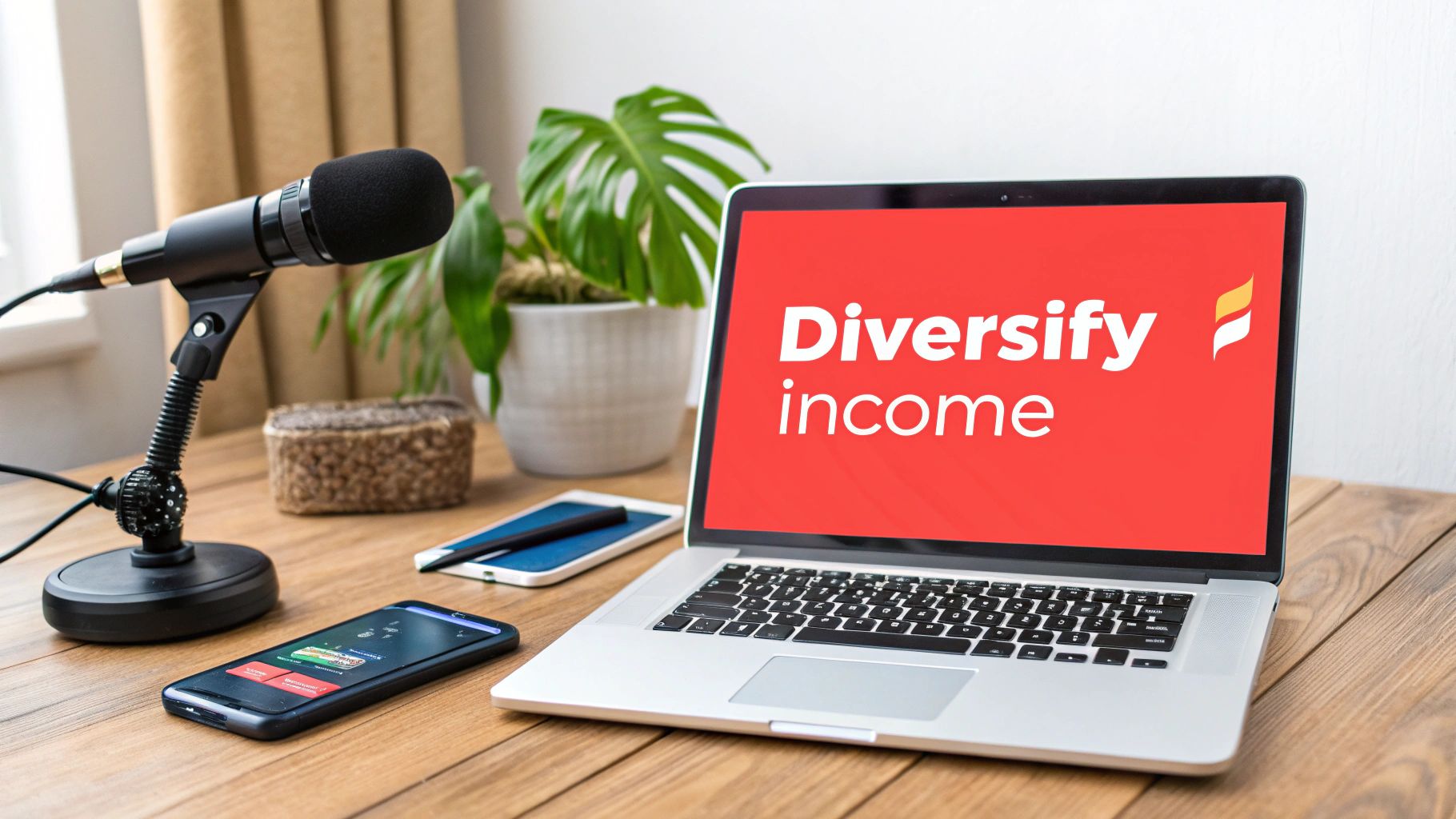So, you want to make money on YouTube? It's a goal for a lot of creators, but figuring out how to actually do it can feel like trying to solve a puzzle. The good news is, it's not as complicated as it seems.
The key to unlocking your channel's earning potential is getting into the YouTube Partner Program (YPP). This is your official ticket to earning a cut of ad revenue and accessing a bunch of other cool monetization features.
But let's be real: getting there is about more than just numbers. It’s about building a community around your content. This guide will walk you through exactly what you need to do, step by step, without the fluff.
Your Path to YouTube Monetization
Turning your YouTube channel from a hobby into a business is a huge step. Many creators get stuck on the specific requirements or don't realize all the different ways they can earn money. Getting into the YPP is the main goal, but it’s really just the starting line.
Think of the YPP as YouTube’s stamp of approval. It shows you’re a creator who consistently makes good stuff that people actually want to watch. Once you're in, a whole world of monetization tools opens up.
This guide is designed to give you a clear, actionable roadmap. We’ll cover:
- Hitting the YPP Milestones: Practical strategies to get the subscribers and watch hours you need.
- Going Beyond Ad Revenue: How to diversify your income with things like memberships and Super Chats.
- Building a Loyal Audience: The secret to creating a sustainable income for the long haul.
How the Money Works on YouTube
It helps to understand where the money is even coming from. YouTube's business model is built on ads, channel memberships, and subscriptions like YouTube Premium. Just to give you an idea of the scale, YouTube recently pulled in around $39 billion in a single year, with a staggering $36.1 billion of that coming from advertising alone.
As a creator in the YouTube Partner Program, you get a direct piece of that pie. YouTube gives you a 55% cut of the ad revenue your videos generate. It’s a powerful model that has turned countless channels into full-time careers. You can dig deeper into these YouTube revenue insights to see the full picture.
What this really means is that your income is directly tied to your audience. The more engaged viewers you have, the more you can earn. It's a straightforward relationship.
To get a quick snapshot of what it takes to start earning and the main ways you'll do it, check out this table.
YouTube Monetization at a Glance
| Requirement / Method | Key Details | Earning Potential |
|---|---|---|
| YPP Eligibility | 1,000 subscribers and 4,000 public watch hours in the last 12 months. | Unlocks all other monetization features on this list. |
| Ad Revenue | Ads are shown before, during, or after your videos. You get 55% of the revenue. | Varies widely based on views, audience demographics, and ad rates (CPM). |
| Channel Memberships | Viewers pay a monthly fee for exclusive perks like badges, emojis, and content. | You receive 70% of the membership revenue after taxes. |
| Super Chat & Super Stickers | Fans can pay to have their comments highlighted during live streams and Premieres. | You receive 70% of the revenue from these features after taxes. |
| YouTube Premium Revenue | You get a portion of a YouTube Premium subscriber's fee when they watch your content. | Based on how much watch time you get from Premium members. |
This table lays out the core components of the YPP. Once you've met the initial requirements, you can start combining these different income streams to build a reliable and growing source of revenue from your channel.
Qualifying for the YouTube Partner Program
So, you want to get paid for your YouTube videos? The first real step is getting into the YouTube Partner Program, or YPP. Think of it as the official handshake from YouTube that lets you start earning money from your content.
You’ve probably heard the numbers, and they can sound a bit intimidating at first: 1,000 subscribers and 4,000 hours of public watch time within the last 12 months. But these aren't just random targets. They're YouTube's way of making sure you've built a real, engaged audience before they start placing ads on your videos.
This whole process is about building a community first, then monetizing it.

As you can see, hitting those YPP milestones is the bridge you have to cross to get from creator to earner. Let's break down how to actually get there.
Getting to 1,000 Subscribers
Hitting that first 1,000 subscribers feels like a huge milestone, and it is! But it's not about begging people to subscribe in every video. It’s about giving them a clear, undeniable reason to want more from you.
What problem are you solving? What unique entertainment are you offering? For instance, a channel that just posts "cooking videos" is too broad. But a channel focused on "30-minute vegan meals for busy parents"? That has a built-in reason for a specific audience to subscribe. They know exactly what they're going to get.
Here are a few things that actually work:
- Nail Your Niche: Be specific. Instead of a general gaming channel, maybe you focus on indie horror games or becoming the go-to expert for a single game like Stardew Valley. This focus attracts true fans.
- Craft a Killer Channel Trailer: You have about 30 seconds to sell a new visitor on your channel. Use it to quickly show them who you are, what kind of videos you make, and why they should stick around.
- Give a Reason in Your Call-to-Action: Don't just end with a generic "like and subscribe." Tie it to future value. Try something like, "If you found this helpful, hit subscribe because next week I'm revealing my three biggest mistakes when starting this project."
The Grind to 4,000 Watch Hours
Honestly, the 4,000-hour watch time requirement is often the tougher nut to crack. It's a true measure of how engaging your content really is. One viral video might get you a burst of subscribers, but it won't get you the sustained watch time you need.
The real key here is creating content that makes people want to watch another video... and then another. Think in terms of series or playlists. A creator making a multi-part series on "Building a PC From Scratch" will rack up watch hours much faster than someone posting disconnected vlogs. Each video naturally leads into the next, keeping viewers hooked.
It's a marathon, not a sprint. I know one creator who finally hit the 4,000-hour mark after consistently uploading one high-quality video every single week for 14 months. It’s all about that steady, consistent effort.
Applying to the Program
Once you've finally crossed both thresholds—and you can track your progress right in the "Earn" tab of your YouTube Studio—it's time to apply.
The application itself is pretty straightforward. You’ll need to:
- Agree to the Policies: First, you have to review and accept the YPP terms. Basically, you're agreeing to play by YouTube's rules.
- Connect Google AdSense: This is crucial. You'll need to link a Google AdSense account to your channel. If you don't have one, you can create one during this step. This is how you'll actually get paid.
- Wait for the Review: After you submit, a real person at YouTube will review your channel to make sure it complies with all their monetization policies and community guidelines. This can take anywhere from a few days to a month, so be patient!
By focusing on creating real value for a specific audience, you'll not only hit these numbers but also build a foundation for a successful channel. For a deeper look at all the rules, check out our full guide on YouTube channel monetization requirements.
Turning on and Optimizing Ad Revenue
So, you made it into the YouTube Partner Program. Awesome! Take a moment to celebrate that—it's a huge milestone. But don't rest on your laurels just yet, because now the real fun begins: actually making money. This is more than just flipping a switch; it’s about being smart with your settings.
First things first, head over to your YouTube Studio and find the "Earn" tab. This is your new command center. You'll see an option to turn on ads for all your existing videos in one go. For most people, this is the best move. Just get them all monetized from the start.

From now on, you can also set your monetization preferences for every new video you upload, which is a massive time-saver.
Choosing the Right Ad Formats
You’ll see a bunch of different ad types you can enable. While it might be tempting to just check every box, it pays to know what they are. The right mix can boost your income without annoying your audience into clicking away.
Here’s a quick rundown of what you’re working with:
- Skippable in-stream ads: The classic ad you see before or during a video. Viewers can skip them after five seconds. These are a must-have.
- Non-skippable in-stream ads: Shorter ads, usually 15-20 seconds, that have to be watched all the way through. They can pay more, but use them wisely—they can also be a bit jarring for viewers.
- Bumper ads: Super short, 6-second non-skippable ads that play before your video. They're quick and less intrusive.
- Display ads: These are the banner-style ads that show up next to your video on desktop. It’s a simple, non-invasive way to add a little extra revenue.
Honestly, for most channels, just enabling all of them is the way to go. YouTube's algorithm is pretty good at figuring out what ad to show to whom. But if your content is, say, a series of short, quick-fire tutorials, a non-skippable ad might feel out of place. Think about the rhythm of your videos.
The Art of Placing Mid-Roll Ads
If your videos are longer than eight minutes, you've just unlocked a secret weapon: mid-roll ads. These are ads you can place during your video. YouTube can do this for you automatically, or you can place them yourself.
I’ll be blunt: place them manually. Always. The algorithm has a knack for dropping an ad right in the middle of a punchline or a critical explanation, which kills the viewing experience. Instead, scrub through your video and find natural breaks—a transition between topics, a quiet moment, or right after you've delivered a key takeaway. Placing ads thoughtfully makes them feel way less disruptive and can seriously increase your earnings without frustrating your audience.
Understanding Your Earnings with CPM and RPM
Once the ad revenue starts trickling in, you'll notice two key metrics in your analytics: CPM and RPM. It’s easy to mix them up, but they tell very different stories.
- CPM (Cost Per Mille): This stands for "cost per 1,000 impressions." It’s what advertisers are paying to show their ads on your videos. This number often looks excitingly high, but remember, it’s not what you actually pocket.
- RPM (Revenue Per Mille): This is your "revenue per 1,000 views." It reflects your total revenue (from ads, Super Chats, memberships—everything) divided by your total views. This is the number that gives you a much clearer picture of what you're actually earning per 1,000 views.
Keep in mind that these numbers can swing wildly based on your niche and where your viewers are. A channel about personal finance with a largely American audience will almost always have a higher CPM than a gaming channel with a global viewership. If you really want to dig deep and get the most out of your strategy, learning about broader campaign optimization principles can give you a much richer understanding of how the whole ad ecosystem works.
Growing Your Income Beyond YouTube Ads
Relying on ad revenue alone is a classic rookie mistake. Think of it like a house built on a single pillar—it might stand for a bit, but it's dangerously unstable. Ad rates swing wildly depending on the season, what advertisers are willing to spend, and even what’s happening in the world. To build a lasting career on YouTube, you have to think bigger. Smart creators know the secret isn't just making money; it's building multiple, independent income streams.
This is the point where you stop just being a YouTuber and start becoming a business owner. The good news? YouTube gives you some powerful built-in tools to get started, letting your biggest fans support you directly.

Unlocking Fan Funding Features
Once you’re in the YouTube Partner Program (YPP), a whole new world of monetization opens up. These aren't just about money; they're about turning casual viewers into a real community.
-
Channel Memberships: This is basically YouTube's version of Patreon. Your viewers can pay a small monthly fee to get special perks like custom emojis, members-only videos, or behind-the-scenes content. A gaming channel could host exclusive livestreams just for members, or a cooking channel could share recipes a week early.
-
Super Chat & Super Thanks: Ever seen those colorful, pinned comments during a livestream? That's Super Chat. Viewers can pay to have their message highlighted, making it a great way to grab your attention during a chaotic live Q&A. For your regular videos, Super Thanks lets them leave a one-time tip right on the video page.
These features do more than just add to your bottom line. They create a deeper connection by giving your most dedicated fans a way to be seen and show their support.
Expanding Beyond YouTube's Platform
While YouTube's tools are a great starting point, true financial freedom comes from building revenue streams off the platform—ones you have complete control over.
Affiliate marketing is probably the easiest place to start. You simply promote products you already use and love, and you get a commission when someone buys through your unique link. If you run a tech review channel, you can drop affiliate links for the cameras and microphones you use in every video description. It feels authentic because you're genuinely recommending the gear.
Selling your own products or services is where the real magic happens. This gives you the highest profit margins and lets you build a brand that's entirely your own.
A fitness creator could sell branded resistance bands and custom workout plans. A musician could sell digital downloads of their sheet music or offer one-on-one lessons. You're turning your audience into direct customers, creating a revenue stream that YouTube can't touch.
Wondering what's possible when you combine these strategies? One creator who started monetizing in April 2021 managed to earn around $225,000 USD in just a few years by mixing ad revenue, channel memberships, and sponsored content. You can dig into more stats about the earning potential of YouTube creators to see what top performers are making.
Each monetization method has its own pros and cons, from the effort you have to put in to the income you can expect.
Comparing YouTube Monetization Methods
Here's a quick breakdown to help you decide which strategies might be the best fit for your channel right now.
| Monetization Method | Effort Level | Income Potential | Best For |
|---|---|---|---|
| Ad Revenue | Low | Low to Medium | All YPP-approved channels |
| Fan Funding (Memberships, etc.) | Medium | Medium | Channels with a loyal, engaged community |
| Affiliate Marketing | Medium | Medium to High | Review, tutorial, and niche hobby channels |
| Selling Your Own Products/Merch | High | High | Creators with a strong brand and dedicated audience |
As you can see, the path to higher income often requires more upfront work, but the payoff is greater control and financial stability.
By weaving these different approaches together, you create a much stronger financial foundation for your channel. To really dive deep into this, check out our guide on how to build multiple income streams for a full breakdown.
Building a Channel That Lasts
Hitting the YouTube Partner Program numbers is a great feeling, but it’s really just the starting line. The real game is building a channel that doesn't just make a little money now, but grows into a sustainable source of income for the long haul.
It’s tempting to chase every viral trend, but that’s a quick recipe for burnout and an unreliable income stream. True success on YouTube comes from building a genuine community—an audience that trusts you and shows up every time you post. This is how you shift from chasing temporary traffic spikes to creating stable, predictable growth.
Get Found: Mastering YouTube SEO
It’s easy to forget, but YouTube is a search engine. In fact, it's the second-biggest one on the planet, right behind its parent company, Google. As of early 2025, YouTube boasts a staggering 2.85 billion monthly active users, and a huge chunk of them are actively searching for answers, entertainment, and tutorials. You can dig into more stats about YouTube's massive user base on awisee.com.
To get in front of that audience, you have to start thinking like they do. Your content needs to be the answer to their search.
Here's how to do it:
-
Keyword Research is Non-Negotiable: Stop guessing what people want to watch. Use keyword tools to find the exact phrases your target audience is typing into the search bar. A video titled "How to Fix a Leaky Faucet with No Experience" will always outperform a vague title like "My Plumbing Tips."
-
Your Thumbnail is Everything: Think of your thumbnail as a movie poster. It has one job: to make someone stop scrolling and click. It needs to be bold, clear, and spark a little curiosity. A killer thumbnail and a strong title are the one-two punch for getting views.
One of the biggest mistakes I see new creators make is designing busy thumbnails with tiny text that's impossible to read on a phone. Always check how your design looks on a small screen. Simplicity and a clear, compelling focal point win every time.
Build a Content Machine That Won't Break Down
Consistency is king on YouTube, but it's also where most creators stumble and burn out. Don't worry, you don't need to post a new video every single day. What you do need is a reliable schedule that your audience can count on.
A predictable upload schedule signals to both your viewers and the YouTube algorithm that your channel is active and serious. This builds anticipation and loyalty.
You don't have to grind it out alone, either. There are tools that can help you maintain a steady pace without sacrificing quality. For instance, if you're working with a lot of still photos, you can create stunning videos with an AI video generator from images to keep your content pipeline full.
At the end of the day, building a channel that lasts boils down to a simple formula: deliver consistent value with searchable content that connects with a specific group of people. This strategy is what turns casual viewers into loyal subscribers, and subscribers into a thriving community—the most valuable asset you can ever build on YouTube.
Common Questions About YouTube Monetization
Once you get a handle on the different ways to make money on YouTube, the practical questions start popping up. Getting these details sorted out can save you a ton of frustration and help you build momentum.
A big one I always hear is about how much you can expect to earn. The truth is, your income, especially from ads, will swing up and down. It's never static. Things like the time of year (advertisers go all-in during the last quarter), where your viewers are, and your video topics all play a massive role. For example, a video on personal finance will almost always earn more per view than a funny cat video, simply because advertisers are willing to pay more to reach that specific audience.
How Long Does It Take to Get Monetized?
This is the question on every new creator's mind, and the honest answer is… it depends. There's no set timeline. I've seen some creators hit the 1,000 subscribers and 4,000 watch hours in just a few months. For others, it's a year-long (or longer) grind.
I know one creator who uploaded a high-quality video every single week, and it still took her 14 months to cross the watch time finish line. It truly is a marathon. The biggest things influencing your timeline are your niche, how good your content is, and how often you're posting. Your best bet is to focus on making genuinely good videos that people want to watch one after another, rather than chasing a viral hit.
Here's a pro-tip: The YouTube algorithm loves consistency. When you upload regularly, you're sending a signal that you’re serious. That builds trust with your audience and, over time, helps the algorithm favor your content.
Understanding Payment Thresholds and Timelines
So you're finally monetized—when does the money actually show up? It’s not instant. First, you absolutely must have a verified Google AdSense account linked to your channel. After that, you won't see a dime until your earnings hit the $100 payment threshold.
Once you pass that $100 mark, AdSense typically sends out payments around the 21st of the next month. Let’s say you earned $120 in May. You should expect that money to land in your bank account around June 21st. It's a reliable cycle once you get into the swing of things.
Something else that often trips people up is what actually counts as a "view" in YouTube's eyes. To get the full picture, check out our guide on how YouTube counts views for a complete breakdown.
Ready to skip the waiting game and start earning from your content right now? MonetizedProfiles sells fully approved YouTube channels, so you can start generating revenue from the get-go. It's a perfect solution for creators who want to jump straight into making great videos without the long wait for eligibility. Take a look at our available monetized YouTube accounts and kickstart your journey.







